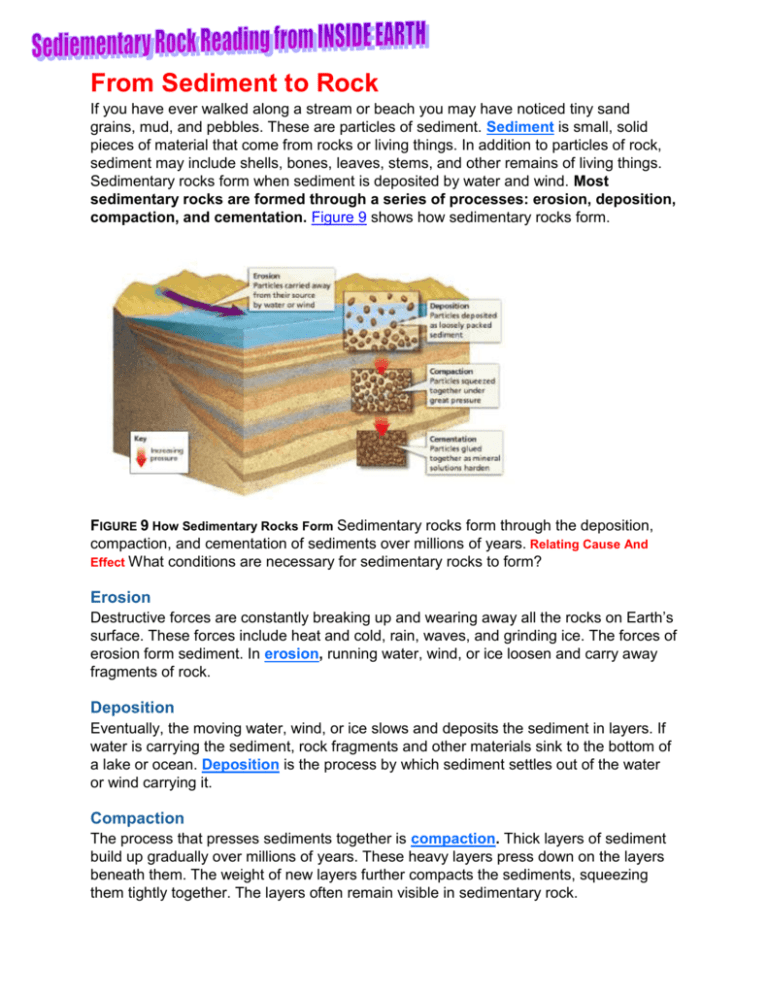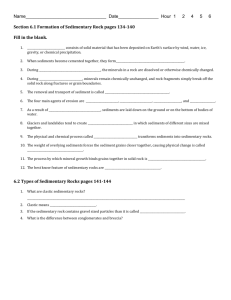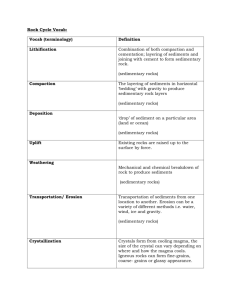From Sediment to Rock reading
advertisement

From Sediment to Rock If you have ever walked along a stream or beach you may have noticed tiny sand grains, mud, and pebbles. These are particles of sediment. Sediment is small, solid pieces of material that come from rocks or living things. In addition to particles of rock, sediment may include shells, bones, leaves, stems, and other remains of living things. Sedimentary rocks form when sediment is deposited by water and wind. Most sedimentary rocks are formed through a series of processes: erosion, deposition, compaction, and cementation. Figure 9 shows how sedimentary rocks form. FIGURE 9 How Sedimentary Rocks Form Sedimentary rocks form through the deposition, compaction, and cementation of sediments over millions of years. Relating Cause And Effect What conditions are necessary for sedimentary rocks to form? Erosion Destructive forces are constantly breaking up and wearing away all the rocks on Earth’s surface. These forces include heat and cold, rain, waves, and grinding ice. The forces of erosion form sediment. In erosion, running water, wind, or ice loosen and carry away fragments of rock. Deposition Eventually, the moving water, wind, or ice slows and deposits the sediment in layers. If water is carrying the sediment, rock fragments and other materials sink to the bottom of a lake or ocean. Deposition is the process by which sediment settles out of the water or wind carrying it. Compaction The process that presses sediments together is compaction. Thick layers of sediment build up gradually over millions of years. These heavy layers press down on the layers beneath them. The weight of new layers further compacts the sediments, squeezing them tightly together. The layers often remain visible in sedimentary rock. Cementation While compaction is taking place, the minerals in the rock slowly dissolve in the water. Cementation is the process in which dissolved minerals crystallize and glue particles of sediment together. In cementation, dissolved minerals seep into the spaces between particles and then harden. Types of Sedimentary Rock Geologists classify sedimentary rocks according to the type of sediments that make up the rock. There are three major groups of sedimentary rocks: clastic rocks, organic rocks, and chemical rocks. Different processes form each of these types of sedimentary rocks. Clastic Rocks Most sedimentary rocks are made up of broken pieces of other rocks. A clastic rock is a sedimentary rock that forms when rock fragments are squeezed together. These fragments can range in size from clay particles that are too small to be seen without a microscope to large boulders that are too heavy for you to lift. Clastic rocks are grouped by the size of the rock fragments, or particles, of which they are made. Common clastic rocks include shale, sandstone, conglomerate, and breccia (BRECH ee uh), shown in Figure 10 . FIGURE 10 Clastic RocksClastic rocks such as shale, sandstone, conglomerate, and breccia are sedimentary rocks that form from particles of other rocks. Shale forms from tiny particles of clay. Water must deposit the clay particles in thin, flat layers. Sandstone forms from the sand on beaches, the ocean floor, riverbeds, and sand dunes. Most sand particles consist of quartz. Some sedimentary rocks contain a mixture of rock fragments of different sizes. If the fragments have rounded edges, they form a clastic rock called conglomerate. A rock made up of large fragments with sharp edges is called breccia. Organic Rocks Not all sedimentary rocks are made from particles of other rocks. Organic rock forms where the remains of plants and animals are deposited in thick layers. The term “organic” refers to substances that once were part of living things or were made by living things. Two important organic sedimentary rocks are coal and limestone, shown in Figure 11. Coal forms from the remains of swamp plants buried in water. As layer upon layer of plant remains build up, the weight of the layers squeezes the decaying plants. Over millions of years, they slowly change into coal. Limestone forms in the ocean, where many living things, such as coral, clams, and oysters, have hard shells or skeletons made of calcite. When these animals die, their shells pile up on the ocean floor. Over millions of years, these layers of sediment can grow to a depth of hundreds of meters. Slowly, compaction and cementation change the sediment to limestone. Chemical Rocks When minerals that are dissolved in a solution crystallize, chemical rock forms. For example, limestone can form when calcite that is dissolved in lakes, seas, or underground water comes out of solution and forms crystals. This kind of limestone is considered a chemical rock. Chemical rocks can also form from mineral deposits left when seas or lakes evaporate. For example, rock salt is made of the mineral halite, which forms by evaporation. FIGURE 12Chemical Rocks These rock “towers” in Mono Lake California, are made of tufa, a form of limestone. Tufa is a chemical rock that forms from solutions containing dissolved materials. Classifying What type of sedimentary rock is tufa? Uses of Sedimentary Rocks People have used sedimentary rocks throughout history for many different purposes, including building materials and tools. For example, people made arrowheads out of flint for thousands of years. Flint is a hard rock, yet it can be shaped to a point. Flint is formed when small particles of silica settle out of water. Sedimentary rocks such as sandstone and limestone have been used as building materials for thousands of years. Both types of stone are soft enough to be cut easily into blocks or slabs. You may be surprised to learn that the White House in Washington, D.C., is built of sandstone. Builders today use sandstone and limestone on the outside walls of buildings. Limestone also has many industrial uses. For example, limestone is used in making cement and steel.








